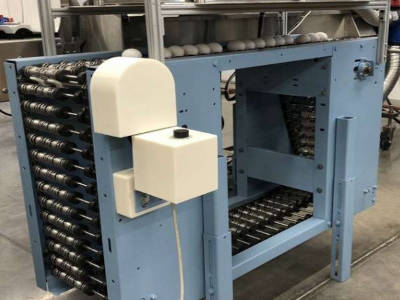By Jeff Mulhollem
Pulsed ultraviolet light can be an effective alternative to some of the antimicrobial technologies now used by the poultry industry to kill pathogens on eggshells, according to Penn State researchers, who simulated production conditions to test the technology.
Researcher Paul Patterson, professor of poultry science, College of Agricultural Sciences, suggests the technology has merit for commercial application in the egg industry.
"This study is unique because it scaled-up and applied components of standard egg processing to a conveyor and sanitizing eggs in a commercial setting," he said. "In the absence of water or other chemical sanitizers, this technology has the potential to achieve significant—equal or greater—microbial reductions than some currently available technologies."
Every year in the United States, an average of 287 eggs are consumed per person, and more than 14.1 billion eggs are set in hatchery incubators to produce chicks destined for the egg and meat bird industries. By reducing the microbial load on eggs, foodborne illness outbreaks associated with eggs and poultry meat can be reduced while chick health is maintained.
The egg industry currently uses sanitizers and detergents to decontaminate eggs and wash off any physical debris, while low-intensity ultraviolet light has been used as an additional antimicrobial step. However, pulsed ultraviolet light is more effective, explained lead researcher Josh Casser, doctoral candidate in animal science, because it delivers a higher intensity of ultraviolet light to the surface of the eggshell. That results in a greater microbial reduction in a shorter period of time than conventional ultraviolet light treatment.
In this study, the surfaces of shell eggs were inoculated with nonpathogenic bacteria strains used for research and were treated with pulsed ultraviolet light derived from a xenon flashlamp. Eggs were exposed on a modified egg-carrying conveyor that provided complete rotation of eggs under the flashlamp.
The novel conveyor devised for the experiment was instrumental in achieving acceptable decontamination, Casser noted, adding that the xenon flashlamps could be scaled up and customized for any commercial installation.

This novel conveyor devised for the experiment was instrumental in achieving acceptable decontamination. As the eggs rotate on their long axis along the way, the entire surface of the eggshell is exposed to the pulsed ultraviolet light energy.
"As the egg rotates on its long axis along the way, the entire surface of the eggshell is exposed to the pulsed ultraviolet light energy, and the 27 seconds of exposure in our experiment resulted in an acceptable germicidal response," he said. "At three pulses per second, each egg is exposed to nearly 90 pulses, and each pulse has a duration of 360 microseconds—an extremely short duration pulse."
The researchers, who recently published their results in Poultry Science, found that pulsed ultraviolet light treatment inactivated two different microbial strains, with greater energy resulting in a greater germicidal response.
The study also evaluated the effects of pulsed ultraviolet light treatment of hatching eggs on both embryo and chick growth. Using the same system, four batches of 125 fertile eggs were treated with the same and greater intensities of pulsed ultraviolet light. After processing, eggs were placed in a commercial incubator under normal incubation conditions.
There was no significant effect of the pulsed ultraviolet light treatment on percent fertility, hatchability or hatch. Also, there were no significant effects on post-hatch observations, including chick livability and average bird weight at hatch or at 42 days of age.
"Our research supports the application of pulsed ultraviolet light as an effective antimicrobial intervention for both table and hatching eggs," Cassar said. "If the egg industry embraces pulsed ultraviolet light technology and applies it in its processing operations, food safety would be improved because of the reduced pathogen presence on the surface of the eggs. And that matters because 9% of all foodborne illness in the U.S. is associated with eggs."
Click here to see more...